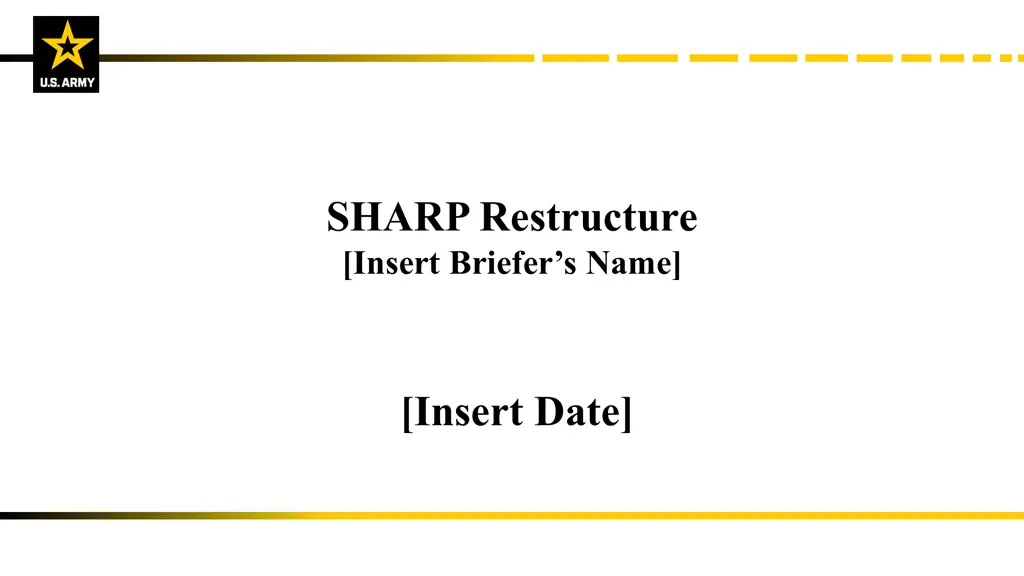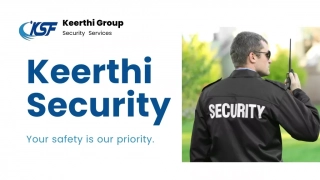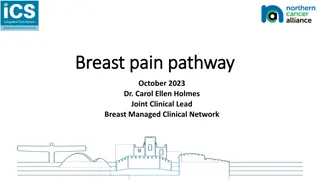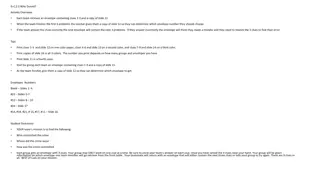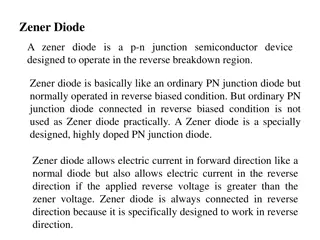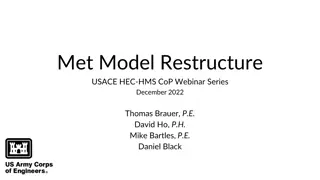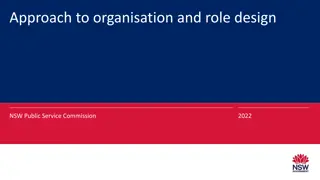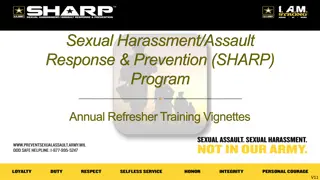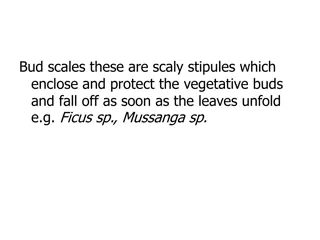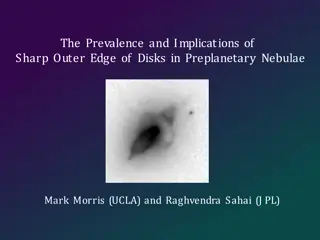SHARP Restructure
The implementation of recommendations from the Independent Review Commission (IRC) on Sexual Assault in the Military, including the removal of SARCs and VAs from the command reporting structure and the professionalization of the SHARP workforce. It also discusses additional changes to the SHARP program, including the role of the Lead SARC and the establishment of a new SAPR Program Manager.
Download Presentation

Please find below an Image/Link to download the presentation.
The content on the website is provided AS IS for your information and personal use only. It may not be sold, licensed, or shared on other websites without obtaining consent from the author.If you encounter any issues during the download, it is possible that the publisher has removed the file from their server.
You are allowed to download the files provided on this website for personal or commercial use, subject to the condition that they are used lawfully. All files are the property of their respective owners.
The content on the website is provided AS IS for your information and personal use only. It may not be sold, licensed, or shared on other websites without obtaining consent from the author.
E N D
Presentation Transcript
SHARP Restructure [Insert Briefer s Name] [Insert Date]
SHARP Future Workforce (IRC Implementation, dated 13 OCT 21) Background: In September 2021, SecDef directed implementation of the recommendations from the Independent Review Commission (IRC) on Sexual Assault in the Military. IRC recommendations became directives, which fundamentally change the SHARP program and our sexual assault response workforce. NDAA 2022/IRC Guidance directs: 4.1 a: Remove Sexual Assault Response Coordinators (SARCs) and Victim Advocates (VAs) from the command reporting structure 4.1 b: Eliminate collateral duty SARCs and VAs, with exceptions for isolated installations CC 2: DoD must undertake a comprehensive approach to professionalizing, strengthening and resourcing the SHARP workforce across the enterprise Significant changes directed: Unit-level SARCs/VAs will be consolidated on the Senior Commander s TDA and report directly to the Lead SARC, outside of the chain of command Requires full-time installation-based response workforce Directs new professional and programmatic oversight structure at major command through secretariat-level Creates new qualification requirements for the Sexual Assault Response Workforce (education and experience) Implements (across Services) a No Wrong Door Approach to Sexual Harassment, Sexual Assault, and Domestic Violence. Services will be provided regardless of affiliation. 1 AUG 23 2
Additional SHARP Workforce Changes (DRAFT DODI 6495.02) Expected Publication: OCT 23 Background: Based on gaps identified by the Services through the Services' workforce reports (submitted January 2023), OSD is directing further changes to the program which include: The Lead SARC will be the single source for SHARP Program advice and guidance to installation leadership (including tenant commands). GOs and commanders will not designate personnel in their own staff to provide them guidance or information impacting SHARP Program matters and/or victim assistance and response. At the tactical level, the Lead SARC will be rated by the SHARP Program Manager at the operational (ACOM/ASCC/DRU) level. The Higher-Level Reviewer will be the Senior Commander and can not be delegated below the DCG. Establishes a new SAPR (Army: SHARP) Program Manager for Combatant Commands, who creates plans, identifies resources, and collaborates with tasked entities to ensure the availability of sexual assault response capabilities for deployments and contingencies within the area of responsibility. (J1 Responsibility) The prohibition against Services and NGB approving exceptions to SHARP policy and hiring additional personnel outside of those listed in the new workforce model. Requires installation Lead SARC through HQDA SHARP oversight of budget and utilizes fenced funding to ensure resources are only spent to support programmatic requirements. 3
SHARP Workforce Installation-Based Model Program Manager at select ACOM/ASCC/DRU; not at Senior Command (installation) level. Lead SARC reports directly to the Senior Commander as a member of special staff. o SARCs and VAs on the installation report to the Lead SARC. o SARCs and VAs remain embedded in brigades, like behavioral health teams (direct victim and command support). All requirements for SARCs and VAs fully funded by DoD based on staffing analysis, with future manpower study requirements. Most collateral duty positions eliminated. Full time installation-based response workforce increased to meet case load. Additionally, SHARP Program Prevention and Support Specialists will be authorized at the Installation Senior Command level. 4
SHARP Workforce Roles and Responsibilities Installation Senior Commander: Ensures coordinated execution of the SHARP Program across all commands and organizations, to include all subordinate and tenant units on installations and in deployed areas, with a primary focus on delivering seamless, timely, and efficient care for victims. Ensures all SHARP professionals are on a command appointment memorandum, have a current D-SAACP certification, a cleared background screening, and are authorized to provide advocacy services. Chairs the monthly Sexual Assault Review Board (SARB) and Quarterly Sexual Assault Response Team. Ensures SHARP Program regulatory compliance and assesses the effectiveness of local policies/procedures. Installation Lead SARC:Serves as the primary focal point for directing and coordinating response activities at the installation (tactical level). Reports to the installation Senior Commander and is supervised and evaluated by a SHARP Program Manager at operational level. Serves in a supervisory role for all SARCs and VA, making a full range of independent personnel decisions, assigning work, establishing performance expectations, and rating/reviewing performance. Manages the SHARP Program for the installation commander by serving as the single source for SHARP Program advice and guidance to installation leadership (including tenant units). Serves as the co-chair of the monthly SARB, Quarterly Sexual Assault Response Team, and oversees the High-Risk Response Teams. 5
SHARP Workforce Roles and Responsibilities SHARP Program Prevention Specialist: Responsible for the planning, execution/coordination, and evaluation of prevention activities (policies, programs, and practices), training, education, and outreach for sexual harassment and sexual assault. SHARP Program Prevention Specialist directly supports the senior commander and is responsible for supporting the coordination and implementation of comprehensive primary prevention activities that address individual, interpersonal, organizational and community factors that contribute to sexual harassment and sexual assault. Serves as the focal point for coordination and collaboration with the installation Integrated Prevention Advisory Group (IPAG). SHARP Program Support Specialist: Serves as focal point for change management, business process improvement and reengineering, organizational capability maturity, and governance. Supports the SHARP Program s organizational activities to include, but not limited to, business processes, information management, and cost management. Develops, analyzes, and evaluates organizational policies; applies appropriate best practices from existing doctrine and emerging industry business practices to support program execution and oversight functions. 6
SHARP Workforce Roles and Responsibilities Supervisory SARC: Complements the role of the Lead SARC at installations with a larger volume of SHARP personnel by supervising and evaluating the activities carried out by SARCs and VAs. Reports to and is supervised and evaluated by the Lead SARC. SARC: Serves as the single point of contact to coordinate sexual assault response when a sexual assault is reported at the installation. Responsible for assigning, monitoring, managing and documenting victim assistance and advocacy activities performed by VAs at the tactical level. Reports to and is supervised and evaluated by the Lead SARC*. Will have direct, unimpeded access to the senior commander when acting on behalf of the Lead SARC or when a victim is experiencing a safety issue. Victim Advocate: Provides non-clinical crisis intervention and ongoing support, in addition to referrals for adult sexual assault victims. Responsible for providing direct victim assistance and advocacy services at the tactical level. Advocacy support includes safety assessment and planning and needs assessment for all adult victims of adult sexual assault and sexual harassment. Reports to and is supervised and evaluated by the Lead SARC*. **Victim Support Specialist: Supports and supplements SHARP capabilities for deployed or expeditionary commands. Provides immediate, non-clinical crisis intervention and limited support during deployments. Completes a warm handoff to full-time SHARP personnel as soon as practicable. Performs support and training functions for the program in garrison when not deployed, works directly for the Lead SARC. *At high-concentration locations, the SARC/VA will be supervised and evaluated by a Supervisory SARC. ** New Capability, HQDA is currently in the planning phase for this position. 7
Rotational Deployments and Contingency Operations Combatant Commands, Army Service Component Commands, and FORSCOM must plan, resource, and execute the SHARP Program during contingencies or wartime. Requirements: Care and safety of victims is the priority, not filing a report with a SHARP Professional. SARC and VA coverage must align with other required support services such as medical, law enforcement, and legal that use area coverage models and/or support via tele-support means. In coordination with the Defense Health Agency, ensure trauma-informed, gender responsive, and competent healthcare and access to the services of a sexual assault medical forensic examiner (SAMFE) to patients who disclose a sexual assault. If not available in the deployed or remote setting the patient will be referred for medical evacuation on an emergency basis to receive the necessary medical, legal, pastoral, and psychological care essential for victims of sexual assault and have the ability to make an unrestricted or restricted sexual assault report with a SARC or VA. Deploying units must ensure there are sexual assault response capabilities available. *Guidance based on current DoDI 6310.09, DoDI 6495.02 Vol 1, and draft DoD Response Workforce Model. 8
SHARP Future Workforce Phases Phase I: Conduct Initial Hiring Actions Phase II: Establish Phase III: Phase IV: Eliminate Most Collateral Duty Consolidate Personnel at Installation Level Supervisory Structure Dependent on Phase I Build Supervisory Response Workforce Structure Strengthen & Professionalize the Force Leadership Development Revise & Update SHARP Academy Curriculum Provide administrative and SHARP program prevention personnel at the installation level Workforce Foundation Established Installation Lead SARC Offices (37) and ACOM/ASCC/DRU level oversight structure (FORSCOM, TRADOC, USARPAC, USAREUR-AF, AMC, and USARC) Conducted manning analysis to create an installation-based WF model for the program Manning analysis results were approved by DoD SAPRO in October 2022 and DCS, G-1 in January 2023 Results of manning analysis provided recommendations for Phase II SHARP hiring actions across the Army Dependent on Phase II Remove SARCs & VAs from operational chain of command (Realign TDA) Aligns all personnel under the new supervisory structure (NLT 30MAR24) Release Updated Army Regulation Lead SARCs and/or Supervisory SARCs will supervise and rate all SARCs on the installation Lead SARC will be rated by the MACOM SHARP Program Manager and be senior rated by the installation Senior Commander Dependent on Phase III Eliminate Most Collateral Duty Personnel COCOM strategy developed during phases I-III will be executed to ensure SAPR capability in remote, austere and deployed theaters of operation Once full-time workforce is in place for one year, a follow-on USAMAA manpower study will refine authorizations across the force and inform any adjustments to the elimination of collateral duty personnel FY22 FY23 FY24 FY25-27 9
Way Ahead for SHARP Restructure HQDA will publish new SHARP Regulation providing policy guidance for execution of the new SHARP program requirements (prevention and response). HQDA will continue to assess future requirements for SHARP assets to assist commanders with prevention and training. Unit-aligned (including tenant organizations) SARCs and VAs will still provide direct victim response and command consultation. Once new model is implemented for 1 year, conduct manpower study to determine any additional requirements. o Manpower study WILL include a close look at the impact of implementing the NDAA 23 requirements (i.e., expanded services to DA Civilians, SH investigations for CID, Office of the Special Trial Counsel UCMJ authorities for SA/SH cases) to determine the impact on the program and the requirement for additional resources. Timeline: o Phase II begins with issuance of EXORD 358-23 and ends when supervisory positions are hired and on board. o Phase III begins when supervisory positions are on board and ends when all SHARP personnel are consolidated under installation Lead SARC, NLT 30MAR24. During this phase, all current SHARP personnel will be moved to standardized position descriptions. o Phase IV begins NLT 30MAR24 and ends once USAMAA completes the manpower study to inform adjustments to the workforce (o/a Q4FY25). During this phase, collateral duty SHARP positions will be eliminated except those with a DoD approved ETP. 10
[Insert] Installation Specific Requirements and Transition Plan Slides Commands Must Address: Explain SHARP coverage plan and provide an organizational chart down to BDE level, including tenant units. (example on next slide) Provide Installation/Command HR Guidance for positions not supported under the new model. Provide an overview of local implementation timelines, as developed by installation staff 11
FOR EXAMPLE ONLY Direct Supporting Relationship Ft. XYZ SHARP Response Workforce SHARP PM Office Lead SARC Program Support Specialist Program Prevention Specialist Supervisory SARC: Name if Known Supervisory SARC: Name if Known Direct Supporting Relationship EOD, USAF, EN BN Medical and Dental HHBN / /DIV ARTY / Band USAG Tenant Units Tenant Units Tenant Units 1stBCT 2ndBCT 3rdBCT CAB SUST BDE SARC: Name SARC: Name SARC: Name SARC: Name SARC: Name SARC: Name SARC: Name SARC: Name SARC: Name SARC: Name SARC: Name SARC: Name VA: Name VA: Name VA: Name VA: Name VA: Name VA: Name VA: Name VA: Name VA: Name VA: Name VA: Name VA: Name 12
Questions? 13
